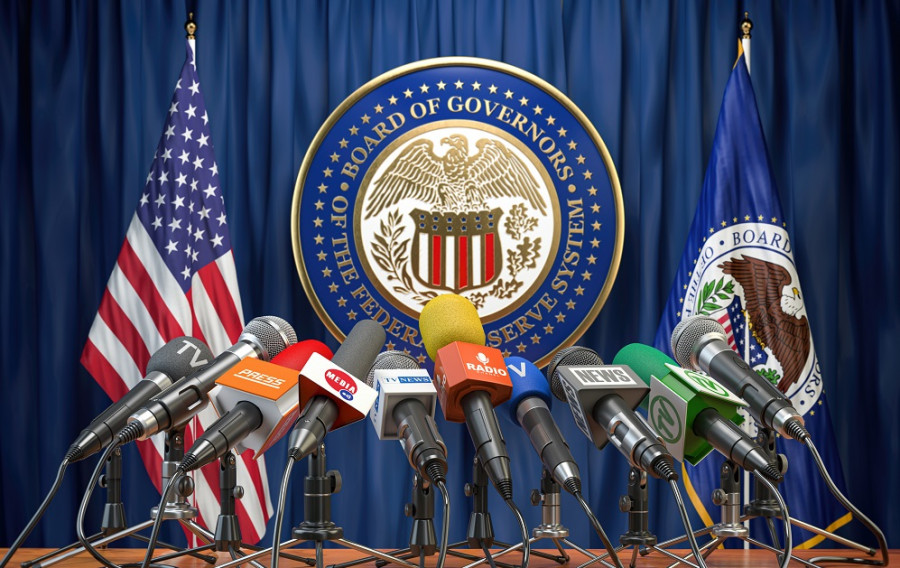Today, the Federal Reserve will conclude its two-day meeting — the penultimate one of the year. While the formal outcomes of the October meeting are largely predetermined, markets are speculating about the intrigue surrounding the Fed's future actions.
As the American trading session comes to a close, the Federal Reserve faces unprecedented circumstances—the first time in six years that its members gather amidst a shutdown that has stretched into its 29th day (just five days shy of a historical record). Unlike the January meeting in 2019, when the central bank maintained all parameters, today the regulator is expected to lower the funds rate by 25 basis points. This is the most basic and anticipated scenario, with the market assigning a 99.9% probability to its realization.

This suggests that the formal outcomes of the October meeting have already been factored into market prices. Traders priced in a 25-basis-point rate cut two weeks ago following a significant speech by Fed Chair Jerome Powell, who expressed concern over the state of the labor market, stating, "the ongoing reduction in job openings will inevitably lead to an increase in unemployment." Other Fed policymakers, including Stephen Miran, Christopher Waller, and Michelle Bowman, supported further monetary easing, intensifying the market's expectations.
In essence, an October rate cut appears to be a done deal. Consequently, traders may choose to disregard the formal announcement of the meeting's outcomes. All attention will be focused on the accompanying statement and the rhetoric from Jerome Powell. The intrigue surrounding the Fed's next steps persists, and several primary scenarios can be delineated.
Hawkish cut In my opinion, this is the most likely scenario, wherein the regulator will cut the interest rate by 25 basis points but refrain from announcing another rate cut for the December meeting. The Fed will deliver a cautious message, suggesting that future decisions will be based on incoming data—specifically after the shutdown concludes.
Essentially, the central bank is currently operating in the dark, with its members making decisions solely based on the September CPI growth report. Unfortunately, other (official) macroeconomic statistics are unavailable. Will the Fed make any categorical forecasts in such an information vacuum? Highly unlikely, especially since not all Fed representatives align with Jerome Powell's dovish stance. Notably, Dallas Fed President Lorie Logan and Atlanta Fed President Raphael Bostic have called for caution regarding further rate cuts.
Moreover, the October Fed meeting occurs on the eve of a crucial meeting between US President Donald Trump and Chinese President Xi Jinping. Preliminary trade talks have been constructive; however, if the leaders fail to find common ground on key issues, the trade war may escalate once again. This potential scenario cannot be overlooked, serving as another argument for a cautious position from the Fed regarding its future actions.
Importantly, according to the CME FedWatch tool data, the probability of a 25-basis-point rate cut in December stands at 90%. Therefore, if the Fed pursues a hawkish cut today, the dollar will likely see increased demand, even in the face of an actual rate cut.
Dovish cut A 25-basis-point rate cut coupled with unequivocal hints at another cut in December. This scenario is less likely due to the reasons mentioned above. However, it cannot be completely dismissed. Proponents of this outcome point to the aforementioned CPI report from September, which revealed a slower overall inflation rate (3.0% against a forecast of 3.1%) and a deceleration in core inflation (3.0%, following August's increase to 3.1%).
Regarding the labor market, "doves" highlight a rise in unemployment benefit claims. Once again, due to the ongoing shutdown, the US Department of Labor has not published official data. However, estimates from Goldman Sachs and JPMorgan suggest that the number of Americans initially filing for unemployment benefits has risen for the third consecutive week. Similar signals have been voiced by Citigroup economists, who estimate an increase in claims last week to 230,000-235,000. All of this indicates that demand in the labor market continues to wane.
Some analysts believe the increase in claims could be attributed to the shutdown. As a rule, surges occur only in the first week following a government work stoppage. In this case, however, we may be witnessing a negative trend.
Another argument in favor of a dovish cut is the Conference Board's Consumer Confidence Index, which has declined for the third consecutive month. According to data published yesterday, the index dropped to 94.6, the lowest level since April of this year.
In other words, the Federal Reserve could theoretically justify not only a 25-basis-point rate cut in October but also the necessity for further monetary easing. If the emphasis is placed accordingly, the dollar could face significant pressure. Still, in my opinion, the regulator is unlikely to adopt such unanimous decisiveness.
Ultra-scenarios These are the least likely scenarios, which could theoretically unfold, but the probability is exceedingly low. For instance, a rate cut of 50 basis points. It's worth noting that, following the September meeting, the 50-basis-point scenario was supported only by Trump's protege, Stephen Miran, a consistent dove. Probably, he will also vote for a 50-basis-point cut today. However, no one on the Committee, apart from him, supports the idea of aggressive monetary easing.
Additionally, the option of maintaining the status quo at the October meeting is highly unlikely. Fed Chair Jerome Powell practically announced a rate cut two weeks ago. The "red tint" of the inflation report dispelled any lingering doubts in this regard.
Conclusions The market's unshakeable confidence that the Fed will implement two rate cuts by the end of this year may prove detrimental to EUR/USD buyers in every sense. For further growth of the pair, the regulator must confirm market expectations.
Will it confirm them? Highly doubtful, given the ongoing shutdown, the upcoming negotiations between Trump and Xi Jinping, and the existing disagreements among Fed members. It means that the greenback could become the beneficiary of the October meeting, even in the face of an actual rate cut. In this case, EUR/USD sellers may once again test the lower border of the range of 1.1560 to 1.1730, within which the instrument has been trading for the fourth week straight.













